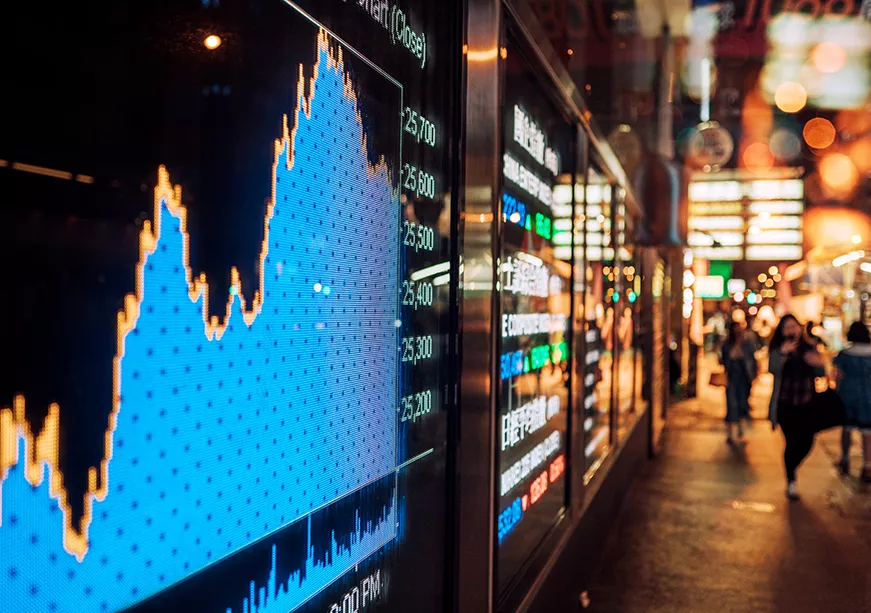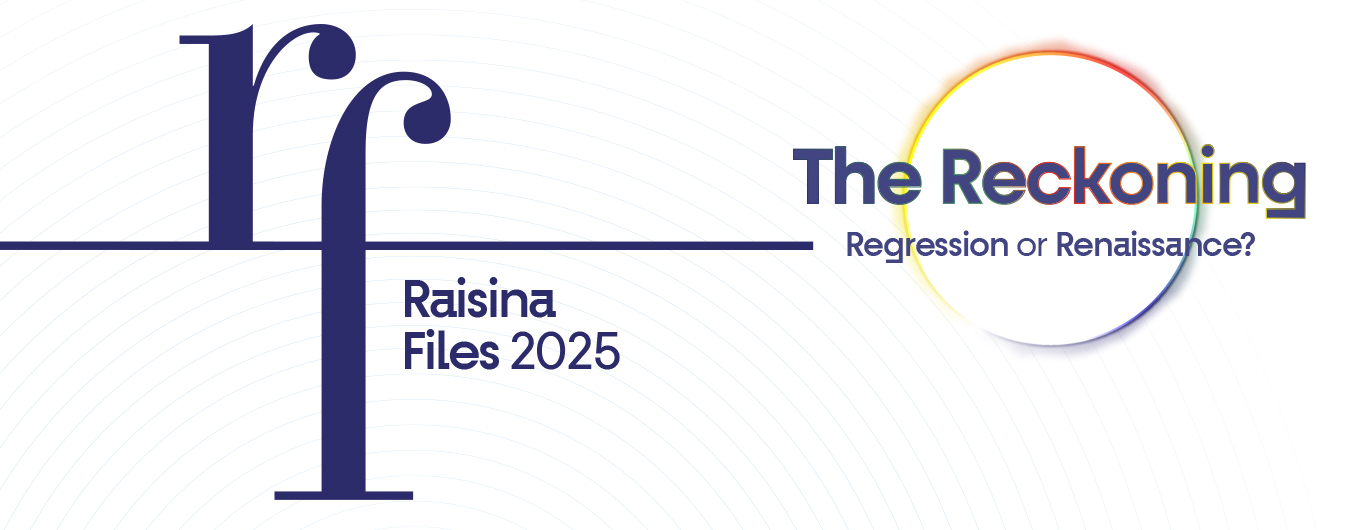
Image Source: Getty
This article is part of the series — Raisina Files 2025
In 2025, Europe stands at a “make-it-or-break-it” moment, confronting a multitude of challenges unprecedented in their complexity and scope. Around 100 years ago, following an era of geopolitical stability, Europe plunged into deep uncertainty painfully mixed with nostalgia. The period of prosperity, during which Europe’s cultural and societal ideals flourished, was swiftly replaced by a dark transformation. In the works of Proust[1] in In Search of Lost Time and Spengler[2] in The Decline of the West, this upheaval is depicted as the end of a cultural golden age and the harbinger of decline. In The Sleepwalkers: How Europe Went to War in 1914,[3] it becomes clear how Europe’s political elites, blind to the looming dangers, almost sleepwalked into the First World War. Only twenty years later, the world Stefan Zweig[4] knew collapsed in collective shock, and the future, once filled with hope and enthusiasm, was replaced by a grim reality of war and destruction. The old stability was irretrievably lost, and the world had changed forever.
Today, Europe bears many similarities to the “world of yesterday” described by Zweig. However, this is less about the decline of Pax Americana—the period of post-war “long peace”, led by the West with the United States (US) at the helm. It is more about the “slow agony” of Europe—economically, demographically, industrially, and technologically, as eloquently expressed by Draghi in his 400-page report.a,[5] Innovations once celebrated—such as a common charger within the EU or the locked lids now fixed on bottles—now signal a growing lack of imagination. Germany is often being referred to as the “sick man of Europe”,6 where nothing functions on time or technologically.
In 2025, Europe is confronted with increasing political fragmentation and the rise of populist movements that could further undermine trust in European Union (EU) institutions and decision-makers within EU countries. The EU, described by Ivan Krastev as “overinstitutionalised and over-regulated,”[7] is struggling to respond to the manifold, cascading crises. Populist movements are gaining ground as many citizens feel that the established elites are incapable of addressing economic and security challenges. This not only jeopardises trust in Europe’s future but also calls into question the political coherence of the continent.
The economic and security problems are closely intertwined, forming a vicious cycle that is increasingly difficult to break. Draghi’s report,[8] which paints a bleak picture of a “lost decade”, illustrates the severe consequences that the combination of industrial and security weaknesses poses for the continent. Demographic changes, the escalating migration crisis, and geopolitical tensions—exacerbated by the unresolved situation in Ukraine, tensions in the Middle East, and volatility in the Indo-Pacific region—are leading to a significant loss of global relevance. Europe is at risk of slipping further into the margins, becoming the geopolitical backyard of international affairs,[9] as the political and economic elites of the continent are caught in a deep bifurcation, triggered by a lack of consensus on their vision for relations with the US, China, and Russia.
The following geopolitical megatrends exert profound influence on Europe’s role in the world, and it seems there is a lack of a clear strategic vision and coherent strategy for its future direction.
Cold War 2.0: America and the DragonBear
The geopolitical bifurcation will intensify in 2025 as the rivalry between the US and the “DragonBear” blocb,[10] fractures the international order and creates centrifugal power relations between the West and the geopolitical bloc of China, Russia, Iran, and North Korea. Europe faces the challenge of positioning itself within this geopolitical bloc system and redefining its relationship with both the US and China. The old formula—security from the US, energy from Russia, and markets and production from China—is long outdated.[11] The new reality increasingly draws Europe into dependency on America in all three areas.
At the same time, European powers are confronted with the failure of their “derisking” approach towards China and must develop a pragmatic line towards Beijing. The implementation of sanctions against Russia remains problematic, particularly when it comes to importing Russian raw materials through third countries. While the transatlantic partnership with the US remains significant, Europe is being drawn closer to the tensions between the US, China, and Russia. Developing an independent European geopolitical agenda is becoming increasingly difficult.
Trump’s second term poses even greater challenges for Europe than his first, especially concerning responsibility for security and defence, as American trust in institutions like the EU and NATO will decline. European countries will likely be forced to invest at least 3-5 percent of their GDP in defence spending,[12] take a vigorous role in supporting Ukraine, and more effectively protect their own neighbourhoods in the Arctic, Eastern Europe, and the Mediterranean.
Escalation of Proxy Conflicts: The Networking of Geopolitical Flashpoints Trump 2.0 promises an end to wars and conflicts involving US participation. The war in Ukraine was supposed to be resolved within 24 hours, and a new summit with Russian President Vladimir Putin, similar to Helsinki 2018,c might not be ruled out. Yet, geopolitically, the winds seem to be shifting: There is still no resolution in sight to the Russian war in Ukraine, nor is there a foreseeable end to Houthi rule in Yemen.
The complex web of tensions in the Middle East and Indo-Pacific will also not resolve quickly. Particularly, the Red Sea and the Middle East are likely to be among the most violent and unstable regions in 2025 despite the ceasefire in Gaza following Trump’s reelection.[13] However, European countries are increasingly focusing on diplomacy and mediation rather than preparing for deterrence. As military expert Stefan Gady puts it: “Those who rely too much on diplomacy risk not being taken seriously.”[14] Gady rightly speaks of “parasitic pacifism”, as Europe has “settled comfortably under the umbrella of others.”
The escalation of proxy wars, particularly in Ukraine, the Middle East, and the Indo-Pacific, will also affect Europe in 2025 and shift the geopolitical balance further away from the European countries. These are also exposed to political instability and key elections, such as in Germany. European NATO members are becoming increasingly ensnared in these conflicts, whether through military support or economic sanctions. While the US increasingly shifts its geopolitical priorities towards the Indo-Pacific, Europe remains reliant on the American security umbrella. This dependency highlights the weaknesses in European defence policy and could present a fundamental test for Europe in 2025.
The ongoing crisis in the Red Sea (although temporarily put on hold), the emergence of a new Iron Curtain along NATO’s eastern flank, and the shifting power dynamics in the Middle East and North Africa add inflationary pressure to European economies. The need for investment in defence, cyber, and security infrastructure will be difficult for European political elites to communicate.
Geoeconomic Fragmentation: Technology, Trade, and Financial Wars
The increasing geoeconomic fragmentation presents Europe with the urgent need to diversify its economic relationships. Geopolitical tensions and Cold War 2.0 context between America and the DragonBear are splitting global supply chains into two alternative networks, forcing Europe to seek partnerships with third countries. While the DragonBear axis presents a challenge to the West, Russia’s role remains complex. For instance, despite its alignment with China, Russia continues to benefit India and the broader liberal order. This is evident in ventures like the India-Russia BrahMos missile deal, which has strengthened the Philippines’ defence posture against China, indirectly contributing to the stability of the global order.[15]
In this context, economic entanglements with China and dependencies on Russia for raw materials raise the question of how Europe can strengthen its economic sovereignty. Europe must increasingly tap into markets in emerging economies—particularly in Africa, Asia, and South America—to secure its geoeconomic position. At the same time, Europe suffers from a loss of industrial competitiveness in the global competition,[16] particularly vis-à-vis the US and China. This is further exacerbated by rising labour and energy costs. These productivity challenges clash with the EU’s lofty climate goals, raising the question of how Europe can maintain its competitiveness while also advancing ambitious decarbonisation efforts. The technology wars between the US and China will further shape global trade policy and the industry in 2025. Particularly in the fields of semiconductor production, artificial intelligence (AI), digital infrastructure, and cybersecurity, Europe is far behind in the competition with the US and China. The increasing decoupling of economic systems between China and the US has direct consequences for European countries, which must not only secure their competitiveness in these key industries but also reduce their dependence on either superpower. The EU has begun investing in semiconductors and digital technologies, yet the gap with the US and China remains significant. The challenge for Europe is to play an independent role in the global technological race amid the Fourth Industrial Revolution without being overwhelmed by the geopolitical tensions between the two frontrunners.
Against this backdrop, the ongoing de-dollarisation tendencies,[17] primarily driven by China and Russia within the BRICS+, will challenge Europe to reassess its financial positioning. While some BRICS nations explore alternatives to the US dollar, India has maintained a more pragmatic stance, emphasising stability rather than outright de-dollarisation, as reiterated by officials such as External Affairs Minister S. Jaishankar.[18] A potential currency basket from the BRICS+ nations could still influence the international financial system, especially in light of Trump’s expected policies in 2025.[19] For Europe, this means not only reaffirming its partnership with the US in the financial sector but also engaging more actively in shaping a multipolar financial system. By fostering deeper cooperation with emerging markets and supporting a more diversified currency landscape, Europe can work towards greater geopolitical and economic resilience without overstating the BRICS agenda.
Geopolitical and Geoeconomic Scenarios for Europe
Europe stands at a critical juncture: either it will succeed in balancing industry, decarbonisation, and security, or it will lose its geopolitical clout in the long term. However, the EU currently faces the challenge of investing simultaneously in AI, semiconductors, and defence to keep up with the US and China—all while European industry becomes greener. Is this even realistic?
A possible scenario could involve making Europe an industrial giant on weak foundations, prioritising industrial competitiveness at the expense of security and decarbonisation. In this scenario, Europe focuses on its industrial base, supported by EU institutions, while massive investments flow into digitalisation, quantum computing, cybersecurity, and AI. However, Europe would become even more dependent on the US in the security domain. Trump would negotiate harshly on trade matters with the EU but might secure adjustments by pressuring Europeans into concessions in Ukraine and importing more American LNG—at the cost of decarbonisation. A ceasefire between Russia and Ukraine, brokered by American negotiations, could, however, mean that Russia continues its hybrid war against Europe and gradually undermines European security arrangements. Recent sabotage operations in the Baltic Sea, involving several countries, offer only a preview of what may lie ahead.[20]
An alternative scenario could involve prioritising new European industries, such as cybersecurity, space, and defence, in favour of European security—and again at the expense of decarbonisation. Under the pressure of Trump 2.0, Europe might increase defence spending to at least 3 percent of GDP, especially in European NATO member states. Europe would focus on protecting its external borders, taking on additional security tasks so that the US can direct its attention more towards the Indo-Pacific and China, and investing in high-tech weapons, cybersecurity, and space capabilities. This scenario could help Europe strengthen its geopolitical position and diversify its trade relations in a fragmented world economy.
Great Opportunities: Geopolitical Alliances, Ambitious Infrastructure Projects, and Eastern Expansion
Despite the geopolitical challenges, Europe also has opportunities to solidify its global role. A key step would be intensifying strategic partnerships with countries from the Global South, particularly in Africa, Asia, and Latin America. Similar to MERCOSUR, South America’s trade bloc, the EU should forge new free trade agreements with countries and regions like India, the Gulf States, ASEAN, and the African Union—this could grant Europe access to new markets and promote international free trade and multilateralism.
Another key opportunity for Europe’s future is the development of strategic infrastructure and multimodal corridor projects, such as the Three Seas Initiative (3SI)[21] and IMEC[22] (India-Middle East-Europe Economic Corridor). These initiatives could help Europe deepen its economic collaboration with emerging economies, overcome geopolitical fragmentation, and establish new trade routes and supply chains. These projects would allow Europe to redefine its economic and geopolitical significance and gain greater access to emerging markets while also creating the missing North-South infrastructure between the thirteen 3SI members of the EU.
What is currently missing from the voluminous Draghi report is the perspective of Central and Eastern Europe. Countries such as Poland, Romania, and Croatia will experience strong economic growth. Infrastructure—particularly transport, energy, and digital corridors running from Scandinavia to Central, Eastern, and Southeastern Europe—still needs to be built. North-South connectivity will increasingly replace the former East-West infrastructure. Former EU Ambassador for Connectivity, Romana Vlahutin, knows how to turn the EU strategy “Global Gateway”—an initiative for building new infrastructure projects such as roads, rail, ports, and data cables—into a success story. She proposes pooling 60 billion euros in development aid and 40 billion euros in export credit support and creating a fund that attracts private investments at a ratio of 1:4 or 1:5. This could generate annual returns of 400 to 500 billion euros and enable investments worth 4 to 5 trillion euros within ten years, promoting ambitious infrastructure projects.[23]
Finally, the European enlargement of the internal market to include countries from the Western Balkans and Eastern Europe represents another crucial geoeconomic opportunity. The geographic and geopolitical location of these countries, serving as a bridge between the EU, Asia, Africa, and the Middle East, could strengthen Europe geopolitically. Integrating these countries into the internal market would not only promote economic connectivity and trade within the EU but also act as a bulwark against the growing Russian and Chinese presence in the region. A stabilised Western Balkans and economic integration of Eastern Europe could further solidify Europe’s geopolitical position and contribute to economic coherence.
Recommendations and Conclusion
The current geopolitical and economic developments suggest that Europe risks losing global significance over the next 15 to 20 years due to structural and systemic changes. For Europe to continue competing as an industrial powerhouse in the international race with China and the US, it must urgently address several interconnected issues simultaneously. First, the problem of declining birth rates and an ageing population in Europe must be tackled through targeted measures in migration, family policy, education, and productivity. Furthermore, Europe must strengthen domestic energy production to secure its energy supply and reduce dependency on other countries. Particularly, Europe should no longer rely solely on LNG from the US, rare-earth minerals and technologies from China, and fossil fuels from Russia. Instead, it should focus on alternative energy sources such as nuclear power, domestic gas production, long-term gas contracts with third countries, and the expansion of renewable energy. Finally, Europe must actively address the growing security threats in its southern and eastern neighbouring regions due to interconnected conflict zones and increasing sabotage actions by China and Russia in the north. Clearly, decarbonisation as a long-term goal will suffer a temporary political setback and be postponed.
Against this background are three key takeaways:
- Europe is at risk of drifting further to the margins, thus becoming the geopolitical backyard of international affairs, while the political and economic elites of the continent are caught in a deep bifurcation due to a lack of vision of how to engage with the US, China, and Russia.
- Europe urgently needs to address several interconnected issues simultaneously—from the demographic crisis to securing energy supply and reducing dependence on global superpowers.
- The challenge for Europe lies also in playing an independent role in the global technological race amid the Fourth Industrial Revolution, without being overwhelmed by the geopolitical tensions between the US and China.
In conclusion, Europe will face one of the greatest challenges in its history in 2025. It must make a systemic decision regarding the continent’s geopolitical and geoeconomic orientation, which will shape its future role in an increasingly divided global order under Trump 2.0. Whether Europe can succeed in asserting itself as a global actor in a bifurcated world, or it will continue to be overwhelmed by geopolitical forces, will help determine the geopolitical and geoeconomic landscape for decades to come.
[a] Mario Draghi—former European Central Bank President and one of Europe’s foremost economists-- was tasked by the European Commission to prepare a report of his personal vision on the future of European competitiveness. It was published in September 2024.
[b] The DragonBear concept is a framework that illustrates how China and Russia coordinate strategically across a broad spectrum of systemically relevant domains—from commodities, economy and trade to the technology, defence, and space sectors. It does not denote a formal strategic alliance or military pact but rather a modus operandi through which both nations align their interests and joint actions across multiple fields.
[c] At the Helsinki summit, Trump and Putin pledged to enhance US–Russia relations and agreed to work together on issues such as terrorism, cybersecurity, and the Syrian conflict. Putin declared that the Cold War was over, while both leaders emphasised that the summit marked an important initial step towards closer, more productive dialogue between the two nations.
Endnotes
[l] Marcel Proust, In Search of Lost Time, Volume 6, Andreas Mayor, Charles Kenneth Scott-Moncrieff, Terence Kilmartin, and Dennis Joseph Enright, trans. (London: Vintage, 1996)
[2] Oswald Spengler, The Decline of the West, Volume One: Form and Actuality (New York: Alfred A. Knopf, 1926)
[3] Christopher Clark, The Sleepwalkers: How Europe Went to War in 1914 (United Kingdom: Penguin Books, 2012)
[4] Stefan Zweig, The World of Yesterday: An Autobiography, Anthea Bell, trans. (New York: The Viking Press, 1943)
[5] European Commission, The Draghi Report on EU Competitiveness, Brussels, European Commission, 2020, https://commission.europa.eu/topics/eu-competitiveness/draghi-report_en#paragraph_47059.
[6] “Is Germany Once Again the Sick Man of Europe?,” The Economist, August 17, 2023, https://www.economist.com/leaders/2023/08/17/is-germany-once-again-the-sick-man-of-europe.
[7] Sascha Lehnartz, “Wir leben heute in einer Gesellschaft der Null-Loyalität,” Die Welt, December 27, 2024, https://www.welt.de/politik/ausland/plus254974120/Ivan-Krastev-Wir-leben-heute-in-einer- Gesellschaft-der-Null-Loyalitaet.html.
[8] European Commission, The Draghi Report on EU Competitiveness
[9] Velina Tchakarova, “Europe on the Verge: Zeitenwende or ‘The World of Yesterday’?” Observer Research Foundation, March 2, 2023, https://www.orfonline.org/expert-speak/europe-on-the-verge.
[l0] Velina Tchakarova, “Cold War 2.0: The US-DragonBear Standoff in a Bifurcated Global System,” Observer Research Foundation, February 21, 2024, https://www.orfonline.org/expert-speak/cold-war-2-0-the-us-dragonbear-standoff-in-a-bifurcatedglobal- system.
[l1] “Emmanuel Macron: Europe—It Can Die. A New Paradigm at The Sorbonne,” Geopolitique, April 26, 2024, https://geopolitique.eu/en/2024/04/26/macron-europe-it-can-die-a-new-paradigm-at-thesorbonne/.
[l2] “Trump Says NATO Members Should Spend 5% of GDP on Defence,” EURACTIV, January 8, 2025, https://www.euractiv.com/section/politics/news/trump-says-nato-members-should-spend-5-ofgdp- on-defence/.
[l3] Ali Harb, “Trump’s Role in Gaza Ceasefire Fuels Arab American Anger with Biden,” Al Jazeera, January 17, 2025, https://www.aljazeera.com/news/2025/1/17/trumps-role-in-gaza-ceasefire-fuels-arab-americananger- with-biden.
[l4] David Knes, “Europa steckt in der Falle des ‘parasitären Pazifismus’,” Kleine Zeitung, November 26, 2024, https://www.kleinezeitung.at/home/19112989/europa-steckt-in-der-falle-des-parasitaerenpazifismus.
[l5] Dinakar Peri, “India Delivers First Batch of BrahMos to Philippines,” The Hindu, April 20, 2024, https://www.thehindu.com/news/national/india-delivers-first-batch-of-brahmos-to-philippines/ article68084161.ece
[l6] European Commission, “An EU Compass to Regain Competitiveness and Secure Sustainable Prosperity,” European Commission Press Corner, January 29, 2025, https://ec.europa.eu/commission/presscorner/detail/en/ip_25_339.
[l7] “De-Dollarisation: More BRICS in the Wall,” ING, October 23, 2024, https://think.ing.com/articles/de-dollarisation-more-brics-in-the-wall/.
[l8] Jayanth Jacob, “De-Dollarisation Not Our Policy or Strategy: India After Yet Another Trump Threat to BRICS,” The New Indian Express, January 31, 2025, https://www.newindianexpress.com/nation/2025/Jan/31/de-dollarisation-not-our-policy-or-strategyindia- after-yet-another-trump-threat-to-brics
[l9] “Trump Threatens BRICS with Tariffs if They Replace US Dollar,” Deutsche Welle (DW), January 31, 2025, https://www.dw.com/en/trump-threatens-brics-with-tariffs-if-they-replace-us-dollar/a-71464802.
[20] Henrik Pryser Libell and Lynsey Chutel, “Norway Seizes Russian-Crewed Ship Suspected of Cutting an Undersea Cable,” The New York Times, January 31, 2025, https://www.nytimes.com/2025/01/31/world/europe/norway-russia-ship-baltic-undersea-cable.html.
[2l] “Three Seas Summit Vilnius 2024,” Three Seas Initiative, April 11, 2024, https://3seas.eu/.
[22] Navdeep Suri et al., “India-Middle East-Europe Economic Corridor: Towards a New Discourse in Global Connectivity,” Observer Research Foundation, April 9, 2024, https://www.orfonline.org/research/india-middle-east-europe-economic-corridor-towards-a-newdiscourse- in-global-connectivity.
[23] Romana Vlahutin, “Europas Entwicklungshilfe braucht eine Neuausrichtung,” Handelsblatt, December 28, 2024, https://www.handelsblatt.com/meinung/gastbeitraege/gastkommentar-europas-entwicklungshilfebraucht- eine-neuausrichtung-02/100096372.html.
The views expressed above belong to the author(s). ORF research and analyses now available on Telegram! Click here to access our curated content — blogs, longforms and interviews.




 PREV
PREV



